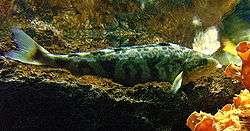Definify.com
Definition 2025
𩸽
𩸽
| ||||||
|---|---|---|---|---|---|---|
Translingual
Han character
𩸽 (radical 195 魚+7, 18 strokes, composition ⿰魚花)
References
- KangXi: not present, would follow page 1473, character 27
- Unihan data for U+29E3D
Japanese
Kanji
𩸽
Readings
Etymology

𩸽 (hokke): an Arabesque greenling / Okhotsk atka mackerel in a tank.
| Kanji in this term |
|---|
| 𩸽 |
|
ほっけ Hyōgaiji |
| kun'yomi |
Unknown. Various possibilities.
- According to legend, the first Japanese person to catch this fish was Buddhist monk Nichiji in the late 1290s, and he named it hokke after the 法華 (Hokke, “Lotus Sutra”).
- May be a shortening of Ainu トドホッケ (todo hotke, “sea lions lie down”), the original Ainu name of 椴法華村 (Todohokke Mura, “Todohokke Village”), a village on the coast of Hokkaido where legend tells that Nichiji first caught this fish.
- May be a borrowing from Ainu ホッケ (hotke, “to lie down”), possibly from the way that the fish sometimes appears to be lying on the bottom.
Considering that the fish is native to the waters off northern Japan where the Ainu were once prevalent, an Ainu derivation seems most likely.
Pronunciation
- Kun'yomi
- (Tokyo) ほっけ [hòkké] (Heiban - [0])[1]
- (Tokyo) ほっけ [hóꜜkkè] (Atamadaka - [1])[1]
- IPA(key): [ho̞k̚ke̞]
Alternative forms
Noun
𩸽 (hiragana ほっけ, katakana ホッケ, romaji hokke)
- a type of fish: Pleurogrammus azonus, common names Arabesque greenling and Okhotsk atka mackerel
Usage notes
This kanji appears to have been coined in Japan (kokuji). It is also extremely rare even in Japanese. The alternative kanji spellings are also rare.
As with many terms that name organisms, this term is often spelled in katakana in biological contexts, as ホッケ. This is also the most common spelling in general contexts.
References
- 1988, 国語大辞典(新装版) (Kokugo Dai Jiten, Revised Edition) (in Japanese), Tōkyō: Shogakukan